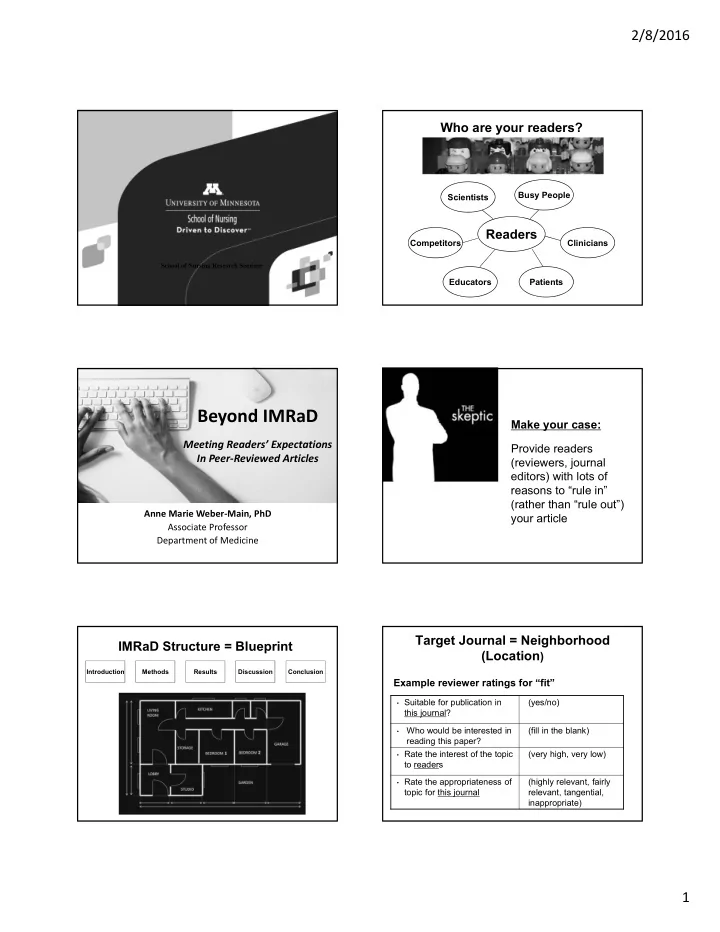

2/8/2016 Who are your readers? Busy People Scientists Readers Competitors Clinicians School of Nursing Research Seminar Educators Patients Beyond IMRaD Make your case: Meeting Readers’ Expectations Provide readers In Peer ‐ Reviewed Articles (reviewers, journal editors) with lots of reasons to “rule in” (rather than “rule out”) Anne Marie Weber ‐ Main, PhD your article Associate Professor Department of Medicine Target Journal = Neighborhood IMRaD Structure = Blueprint (Location ) Introduction Methods Results Discussion Conclusion Example reviewer ratings for “fit” • Suitable for publication in (yes/no) this journal? Who would be interested in (fill in the blank) • reading this paper? • Rate the interest of the topic (very high, very low) to readers • Rate the appropriateness of (highly relevant, fairly topic for this journal relevant, tangential, inappropriate) 1
2/8/2016 Choosing a Target Journal Choosing a Target Journal • Consider journal features • Consider Journal features – Scope and Audience: Match with your article’s message? – Scope and Audience: Match with your article’s focus and – Impact factor message? – Acceptance rate Example: Ethnicity and Disease – Circulation (# of subscriptions) – Abstracting/indexing Focus: Causal relationships in the etiology of common illnesses – Frequency of publication (quarterly, monthly, weekly) through the study of ethnic patterns of disease • Read the journal, identify “model” article Multidisciplinary journal: Epidemiology, genetics, health services, • Make a list (3-5 targets) social biology, anthropology • Top-tier will triage, often rapid response Subscribers : Physicians, medical researchers, other healthcare providers who treat patients and conduct research in the U.S. and • If reviewed, but rejected – use comments to improve abroad. your article Persuading the Skeptic, Section by Section Example: Pediatric Blood and Cancer 3. Results • Basic and clinical investigations of blood disorders Is there enough 2. Methods detail to discern and malignant diseases of childhood, including Was useful, quality? credible information Replicate? diagnosis, treatment, epidemiology, etiology, biology, acquired to help Was the study discern an answer? and molecular and clinical genetics of these diseases well-designed to answer to the as they affect children, adolescents, and young question? adults • Studies on treatment options such as hematopoietic 4. Discussion and 1. Introduction Conclusion stem cell transplantation, immunology, gene therapy Did the authors What answer do ask an important the results research provide? Does the question? answer matter? To whom? Annals of Internal Medicine Use of IMRaD format ≠ Article Type (length) Description well-written article Original Research Reports of original research on prevalence, (1500 to 3200 words) causes, mechanisms, diagnosis, course, treatment, and prevention of disease. Conclusion Introduction Methods Results Discussion Research and Reporting Papers about research methods or reporting Methods (2500 to 4000) standards. “Scientific papers are not just baskets carrying Reviews: Narrative Descriptions of cutting-edge and evolving unconnected facts like the telephone directory; (3500 to 4000) developments, and underlying theory. they are instruments of persuasion. Reviews: Systematic & Reviews that systematically find, select, Meta-Analyses critique, and synthesize evidence relevant to Scientific papers, even if they are based on (3500 to 4000) well-defined questions about diagnosis, sound research, must argue you into believing prognosis, or therapy. what they conclude; they must be built on the Letters: Clinical Short research or case reports. principles of critical argument” (p. 60). Observations (600) Clinical Guidelines Summaries of official or consensus positions Huth EJ. Writing and Publishing in Medicine . 3rd ed. Baltimore, MD: Williams & Watkins; 1999. including Synopses (4000) on issues related to clinical practice, health care delivery or public policy. 2
2/8/2016 Research paper as critical argument 2. Be specific in arguing for your project’s Introduction significance. LIKA (“little is known about”) is not a sufficient justification! Article Element of Example: Section Critical Argument Problem (question) – and its To our knowledge, projects studying the use of rapid HIV Introduction importance! testing in community outreach settings have not been reported. Results Evidence (the data), initial answer This is an important area for research, because many outreach clients: Materials and Credibility of evidence • Are at high risk for HIV methods • Do not access HIV testing through standard venues (clinical settings) Your valid evidence; supporting • Are highly mobile, unlikely to return for test results Discussion and evidence from others; contradictory after standard (non-rapid) testing . Conclusion evidence; final assessment of all evidence. Answer! Postgrad Med 2005;117(3):47-52. AIDS 2006;20:1655–1660 Adapted from p. 65 of Huth EJ. Writing and Publishing in Medicine . 3rd ed. Baltimore, MD: Williams & Watkins; 1999. Try this at home: Introduction and Methods = Foundation 1. Rapidly read the introduction to a published article 2. In 5 minutes or less, create a list of reasons (short bullet points) that the authors provide for why their work is important. Before you draft your own introduction, ask yourself: • What important health or educational challenge/opportunity does this work attempt to address? (There could be more than one!) • What important unanswered question(s) or gap(s) in knowledge does this work attempt to answer? • Who might be interested in the answer to this question? Readers (and reviewers) expect that you have… 3. Use “funnel” format to organize your Introduction significance argument. Investigated an important (significant) question. Introduction Scope of problem, 1. Don’t assume readers will “get it.” Instead, directly address need, value, importance of your work by answering questions significance such as these in the text: What we know Research article: • What gap in knowledge does this project fill? • How will filling this gap move the field forward? Gaps Review article: • Why is a review needed on this topic? Why now? Education innovation: Purpose Statement • What is novel about your approach? What educational need does it (research question, fill, what challenge does it overcome, or what opportunity does it hypothesis) leverage? 3
Recommend
More recommend